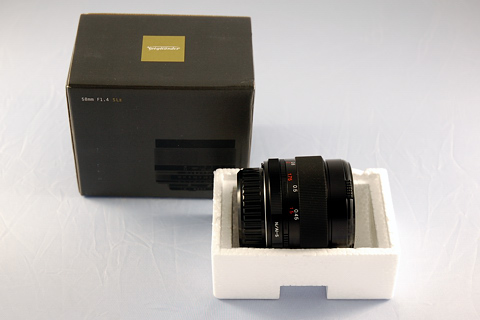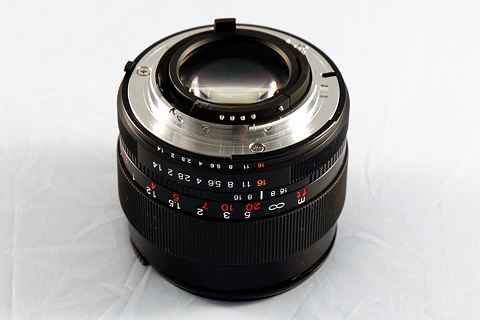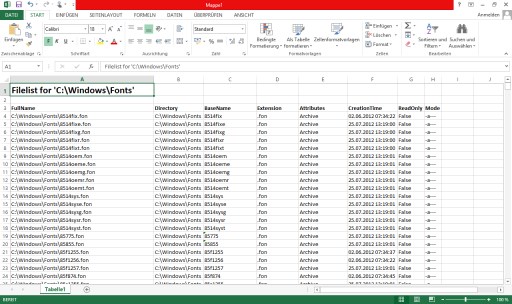-
Fisheye MC Zenitar-N 16mm f/2.8 Lens
The Zenitar 16mm f/2.8 is a manual focus/aperture full frame fisheye lens manufactured in Krasnogorsk/Russia. The full frame (the covered rectangle of the projected image circle) covers 180 degree FOV in diagonal on 35mm. See http://wiki.panotools.org/Fisheye_Projection and http://wiki.panotools.org/Special_issues_with_fisheye_lenses. The lens is available for different mounts (M42, Nikon, Canon, ...). Zenitar-N is the model with a built-in Nikon F-mount and that is the model I ordered:
Here it is. Arrived in a weather proof bag from Russia:
Protected against the mail carrier:
With the seal already broken:
Inside the nylon case:
Wrapped in paper and authentically Russian manual:
And individually certified:
And it fits on the Camera (Nikon D-50)
With three additional color filters available
which get screwed in (at the F-Mount side):
But there was problem. The lens didn't focused to infinity. Instead the lens focused from 0.05m to about 1m. The picture were really sharp there, almost like a macro, but no one needs a fisheye macro. Sending back the lens? I already waited three weeks.
Why does the lens doesn't focus at infinity? For some reason the distance settings ring wasn't aligned with the lens setting. Infinity for the distance ring didn't match the position for the internal lens ring. See the left drawing. With the wrong aligned distance ring, the distance range of the lens is shifted from 0.3m-infinity to 0.05m-1m.
How to fix this? The distance ring needs to be aligned with the internal lens ring to allow the lens to be focused to infinity. This is illustrated in the right drawing. With the new aligned distance ring, the infinity distance can now be set. The minimal distance moved up from the 0.05 to the 0.3m.
The first step is to move back the rubber ring of the distance ring. Do not use any sharp tools, just slide the rubber back on one side a little bit and go around in a few circles to move it back slowly. On the lens barrel you will see three small holes (every 120 degree around the barrel) with a very small screw inside.
There are also three very tiny holes for the lens hood. Be careful with the tiny screws. Choose a screwdriver that matches the size perfectly. Do not use one that is too small. You might break the screw. (You screw up the lens!).
To have the lens focus to infinity, the lens hood needs to be adjusted as well. When you rotate the distance ring to infinity, the lens barrel extents towards the lens hood and might be blocked there preventing the lens extending to the infinity setting.
Don't remove the screws holding the distance ring. Just unscrew until the distance ring moves without being attached to the internal ring. Rotate the distance ring towards a smaller distance and tight the screws just to move the internal ring towards infinity. Look at the illustration above. You are moving the outer distance ring to shift the internal distance ring. For the lens I received the infinity settings was exactly at the stop position of the internal distance ring. I had to move the ring as much as possible towards the infinity setting and the adjust the outer distance ring to match the red mark with the infinity symbol. Once this is done, carefully tight the screws and slide the rubber ring back.
The Nikon D-50 for example cannot meter with this lens and the internal flash is disabled. You need to use the manual setting, set the exposure time manually and use an external flash (SB600/800) set to manual mode if you want to use a flash. At f/5.6 the lens seems to have an optimal aperture.
Some samples:
With the sun in the front:
Das Objektiv Zenitar-N mit einer Nikon D700.
The Zenitar-N mounted on Nikon D700.
Beispielbilder mit unverkleinertem Ausschnitt des Randbereiches:
Sample pictures with 100% crop from the border:f/2.8:
100% crop:
f/4.0:
100% crop:
f/5.6:
100% crop:
f/8.0:
100% crop:
f/11.0
100% crop:
f/16.0
100% crop:
f/22.0
100% crop:
Nahaufname:
Close focus:Unverkleinerter mittiger Bildausschnitt:
100% center crop:Entfernung auf Unendlich:
Infinity focus:100% crop
Gegenlicht:
Lens flare: -
Nokton 58mm F1.4 SL II
Im November 2007 hat Cosina/Voigtländer zwei neue Objektive für Nikon- and Pentax-Systeme vorgestellt: Ultron 40mm F2 SL II und Nokton 58mm F1.4 SL II.
In November 2007, Cosina/Voigtländer announced the Ultron 40mm F2 SL II and the Nokton 58mm F1.4 SL II for Nikon and Pentax systems.
Dieser Kurzbericht ist für das neue Nokton 58mm F1.4 SL II für Nikon.
This overview is for the new for Nokton 58mm F1.4 SL II Nikon.
Das Objektiv ist ganz aus Metall und macht einen sehr stabilen Eindruck.
The lens is all metal with manual focus and feels very solid.
Das Nokton-Objektiv verfügt über eine CPU und kann damit Belichtungsinformationen bereitstellen.
Der Blendenring muß auf f/16 gestellt werden (in orange).The Nokton is a CPU lens and meters on all Nikon DSLR.
The aperture ring needs to be set to f/16 (orange).
Beispielbilder mit f/1.4:
Samples shot with f/1.4:
Die Tiefenschärfe ist bei f/1.4 sehr gering und die richtige Entfernung ist nicht immer einfach einzustellen.
Als Einstellungshilfe kann der grüne Punkt in der Anzeige verwendet werden, der angezeigt wird, wenn das Objekt in der Mitte scharf dargestellt wird (AF-Mode ist für Einfachfeld [.]).The depth of field is of course very shallow at f/1.4 and the focus can be difficult to set.
In the viewfinder, a green dot is displayed for subjects in focus in the center frame (The AF mode is set to Single Area [.]).



f/1.6 1/40s (aus der Hand ohne Stativ)
f/1.6 1/40s (handheld)
1:1 Ausschnitt der unteren linken Ecke
1:1 crop lower-left corner
f/1.4 1/10s (Stativ)
f/1.4 1/10s (tripod)
1:1 Ausschnitt
1:1 crop
f/2.0 1/60s

1:1 Ausschnitt
1:1 crop
f/3.2 1/125s

1:1 Ausschnitt
1:1 crop
f/2.5 1/100s

f/2.5 1/80s

f/3.5 1/200s

f/2.8 1/125s

f/8 1/800s

1:1 Ausschnitt
1:1 crop
f/7.1 1/800s

1:1 Ausschnitt
1:1 crop
f/8 1/1000s

1:1 Ausschnitt
1:1 crop
Erstes Panoramabild mit dem Nokton-Objektiv:
Unter Verwendung der Pano-Tools wurde der 'b'-Parameter, der zum Ausgleich der Tonnenverzerrung verwendet wird, auf einen sehr geringen Wert von -0,001406 optimiert.First panoramic image using the Nokton:
Using the pano tools, the 'b' parameter used for the barrel distortion was optimized to a very low value of -0,001406.f/6.3 1/640s


Nachtaufnahmen mit dem Entfernungsring auf Anschlag unendlich:
Night exposures with the distance ring at infinity:
f/1.4 13s
f/1.4 13s
f/2 6s
f/2.8 10s -
.NET nullable type
A .NET nullable type is a data type accepting a null value.
So how is it different from assigning a null value in C or C++?
In C/C++ a null is a 0.
This is how the null is defined in C/C++:
#define NULL 0The define statement is a text processor directive to use the new defined value in the pre-parsing stage on the source code before the compiler sees it. BTW: Values like true or false are also int:
#define FALSE 0#define TRUE 1But in .NET a null and a 0 are two different values. In C#, basic data types like int or bool are not nullable types by default.
Promoted to a nullable type adds the null. Take for example a bool: The bool type is an enumeration of the two values true and false. A nullable bool adds a null to the set increasing the cardinality to 3.
Useful? Yes, making them a perfect data type to handle the undefined state besides the boolean result.
Nullableflag = null; Or using the short form (T? = nullable
): bool? flag = null;In Windows Powershell:
[nullable[bool]]$flag = $nullNote: extending the value set can change semantics (the meaning) with existing syntax (the form).
The following is not valid anymore because you cannot cast a nullable bool to a bool to evaluate the expression.
Is flag null or false?
if(!flag) { Console.WriteLine("false"); }You need to be specific in the evaluation because squishing a set of 3 values to a set of 2 values in not possible without data loss.
if(flag == false) { Console.WriteLine("false"); } -
PowerShell - ConvertTo-XLSX using fast automation
Windows Powershell has several cmdlets to output data to different formats. CSV, XML, HTML and JSON for example, but Excel is missing. And this is for a good reason: an Excel document is specific to the problem and not to the data. CSV is aligning the data in text rows, XML/HTML packs data in a tag structure and JSON uses its own text structure to serialize, but no one stores raw data in the Excel format for itself.
If you like to use Excel with your data and you don't need any additional formatting, go with the fast CSV. But if you like to create a native Excel document with a customized data presentation, you can use ConvertTo-XLSX.
The following picture show how ConvertTo-XLSX outputs the data. The data might reside on different sheets or position and might be transformed using the different Excel graphical functions. This code is about fast automation and use only little of what Excel has to offer to format your data.

The fast automation is achieved by using an Excel Range and select all data in one automation step. The header line is still done using individual cell automation to allow customizable appearance like bold or colored entries.
Once all data is collected, the data is transferred to a matrix. Then the data is assigned to an Excel Range using ToExcelColumn to compose the area (A1 notation).
Function ToExcelColumn([int]$col) { # Author: Jürgen Eidt, Dec 2012 # to Excel column name conversion [string]$base26 = "" # Convert to modified base26 while ($col -gt 0) { [int]$r = ($col - 1) % 26 $base26 = [char]([int][char]'A' + $r) + $base26 $col = ($col - $r) / 26 } $base26 }The ConvertTo-XLSX function accepts pipe input and optional parameters for Title and FilePath to store the Excel file.
Note:
In this example, one specific Excel version is used:
$xl = New-Object -ComObject "Excel.Application.15"For general purpose, use:
$xl = New-Object -ComObject "Excel.Application"Function ConvertTo-XLSX { # Author: Jürgen Eidt, Dec 2012 param( [Parameter(Mandatory, ValueFromPipeline)] $InputObject, [Parameter()] [string]$Title, [Parameter()] [string]$FilePath ) begin { $objectsToProcess = @() } process { $objectsToProcess += $inputObject } end { # create the Excel object $xl = New-Object -ComObject "Excel.Application.15" $wb = $xl.Workbooks.Add() $ws = $wb.ActiveSheet $cells = $ws.Cells [int]$_row = 1 [int]$_col = 1 # add optional title if($title -ne "") { $cells.item($_row,$_col) = $Title $cells.item($_row,$_col).font.bold = $true $cells.item($_row,$_col).font.size = 18 $_row += 2 } if($objectsToProcess.Count -gt 0) { $Columns = $_col # add column headings in bold foreach($property in $objectsToProcess[0].PSobject.Properties) { ($cell = $cells.item($_row,$_col)).Value2 = $property.Name $cell.font.bold = $true $_col++ } [int]$Rows = $objectsToProcess.Count [int]$Columns = $_col - $Columns # create the data matrix that is later copied to the Excel range $XLdataMatrix = New-Object 'string[,]' ($Rows),($Columns) $z = 0 # add the data foreach($data in $objectsToProcess) { $s = 0 # write each property data to the matrix foreach($property in $data.PSobject.Properties) { if($s -ge $Columns) { break } if($property.Value -ne $null) { $XLdataMatrix[$z,$s] = $property.Value.ToString() } $s++ } $z++ } $_row++ $_col = 1 # create the range argument for the matching data matrix, for example: "A1:K100" $rangeArg = "{0}{1}:{2}{3}" -f (ToExcelColumn $_col), $_row, (ToExcelColumn $Columns), ($_row+$Rows-1) # copy the data matrix to the range $ws.Range($rangeArg).Value2 = $XLdataMatrix } [void]$ws.Columns.AutoFit() [void]$ws.Rows.AutoFit() # show the new created Excel sheet $xl.Visible = $true if($FilePath) { $wb.SaveAs($FilePath) } # release Excel object, see http://technet.microsoft.com/en-us/library/ff730962.aspx $xl.Quit() [void][System.Runtime.Interopservices.Marshal]::ReleaseComObject($xl) Remove-Variable xl } }Use the function like all other convertTo functions to convert the data presentation. You might want to fiilter the data first for specific properties to be used.
$path = "C:\Windows\Fonts" Get-ChildItem -Path $path -File -Recurse | ConvertTo-XLSX -Title "Filelist for '$path'" -
Excel Columns
To use a fast Excel automation, you assign the data matrix to an Excel Range, but ranges in Excel use letters for the column.
Columns start with A to Z, then continues with AA until ZZ and AAA from there all the way to the system limit.
So how to convert the column index to the Excel Column naming?
It is not a base 26 numbering schema: The ones-digit has a value range from 0..25 and all higher order digits have a range from 1..26.
Bijective base 26 on http://en.wikipedia.org/wiki/Hexavigesimal talks about this, but has a broken algorithm. AAA is not 677 but 703 (corrected for one-based numbering). The implementation skips one letter in the higher order digits.
The correct numbering is:
1=A : 26=Z 27=AA : 702=ZZ 703=AAA :This text file contain all columns up to 20000:ACOF (and this ZIP from 1..AAAAA).
Combined with the fact that Excel indices start from 1 instead of 0, I developed the following solution (implemented in Windows Powershell):
Function ToExcelColumn([int]$col) { # Author: Jürgen Eidt, Dec 2012 # to Excel column name conversion [string]$base26 = "" # Convert to modified base26 while ($col -gt 0) { [int]$r = ($col - 1) % 26 $base26 = [char]([int][char]'A' + $r) + $base26 $col = ($col - $r) / 26 } $base26 }For completeness: The reverse operation (from column representation to the actual int value):
Function ExcelColumnToInt([string]$A1) { # Author: Jürgen Eidt, Dec 2012 # Excel column name conversion [int]$col = 0 [char[]]$A1.ToUpperInvariant() | % { $col = 26 * $col + [int]$_ + 1 - [int][char]'A' } $col }